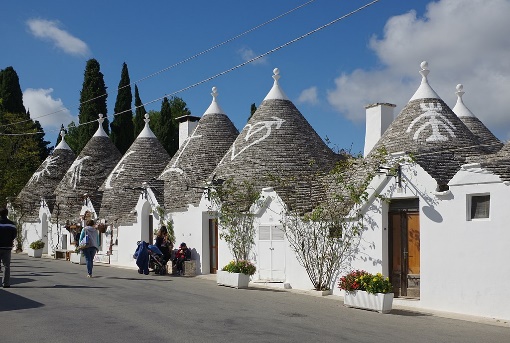

Trulli in Alberobello (photo by Berthold Werner, CC BY-SA 3.0, https://commons.wikimedia.org/w/index.php?curid=60159414)
The trullo, which is a distant heir to the exquisitely Mediterranean construction model of the thòlos, with its recognizable truncated-conical shape, is a dry construction that arises from wisdom and peasant ingenuity. To make the stony limestone soil of the area cultivable, farmers were forced to remove the abundant layers of rock present in the soil and decided to use them as a building material. Even the modern traveler who arrives in Alberobello has the impression of being in a place out of time and in a magical dimension; however, these buildings are relatively recent and originate not so much from magic but for much more practical reasons – precisely for tax reasons! The trulli of the Apulian Murgia are inextricably linked to the fame and black legend of the Count of Conversano, Gian Girolamo Acquaviva d Aragona, known as the Guercio di Puglia. The feared feudal lord, known for his unscrupulousness and for a very ambitious policy, administered these territories in the seventeenth century in the name of the Spanish Viceroys. The local tradition says that the count, greedy for profits, in contravention of the royal ban on building new cities, had allowed the construction of the trulli to better exploit the agricultural resources of those lands and the work of peasants. On occasion of the control visits, the Guercio is said to have the cones hurriedly demolished and then rebuilt, as soon as the Spanish ‘tax assessment’ was concluded.
One of the characteristics of the trulli is that each one bears a strange design on top, in addition to a carved pinnacle; these are symbols of different nature: some refer to age-old pagan or esoteric traditions, others allude to Christian iconography. They are made with lime milk directly on the chiancarelle, that is, the stones that make up the cone of the roof. These drawings did not only distinguish the families who owned the trulli, but took on an apotropaic value, they were believed to remove the evil eye and propitiated a good harvest. The most common and easily recognizable symbols are: the Jewish candlestick, the symbol of the Sun-Christ, the pierced heart of Mary which alludes to the Passion. Other pagan symbols very common on the trulli of Alberobello are those of Taurus, Jupiter and Venus.